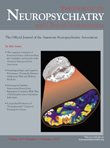Pathological Hyperfamiliarity for Others From a Left Anterior Cingulate Lesion
SIR: Person misidentification syndromes usually involve the misperception of familiar persons or a loss of familiarity for normally perceived ones. We report a unique patient who developed the opposite, a sense of hyperfamiliarity for unfamiliar persons after a hemorrhage in the left anterior cingulate cortex (ACC).
Case Report
A 34-year-old man developed an acute onset of a severe headache, followed by transient loss of alertness. He spontaneously recovered but 2 days later was hospitalized because of new-onset generalized seizures. The patient had a negative medical history and was on no medications at the time of admission.
On initial examination, he was in a postictal delirium. He had otherwise normal examinations of his cranial nerves, motor systems, and reflexes. He was loaded with phenytoin without further seizures. A computed tomography (CT) scan revealed a hyperdense region located in the left anterior cingulate cortex consistent with a hemorrhage. Angiography and magnetic resonance imaging (MRI) revealed a cavernous angioma. On electroencephalography, there were theta waves in the left frontocentral region.
One day after admission, mental status examination revealed an akinetic mute state. He was totally indifferent to external stimuli. Over the following days, the patient had gradually increasing verbal output and behavioral initiation. On day 7 after admission, neurobehavioral testing revealed normal orientation, attention, language, constructional abilities, calculation, reasoning, and judgment with impairment in verbal learning.
Surprisingly, the patient repeatedly expressed strong sensations of having previously known many of the hospital personnel. Sometimes he would ask if he knew them from school or his hometown, a rural village. The patient recognized that his feelings of familiarity were incorrect and strange but he continued to report the presence of these feelings. His sense of hyperfamiliarity for strangers gradually disappeared over a 2-week period, and he was discharged fully recovered.
Comment
The present case provides further evidence for the “assoziierende Erinnerungs- falschungen” phenomenon, or the sensation that unknown people are already known, originally described by Emil Kraepelin. 1 This person hyperfamiliarity syndrome is distinct from Fregoli’s phenomenon, in which strangers are identified as familiar persons. 2 Fregoli patients change the personal identities of surrounding persons, but this patient only felt that they were familiar and did not change their identities.
This patient had a focal lesion in the left ACC, or Brodmann’s Area 24. This corresponds to the “affect” region of the ACG, which regulates emotional awareness, as well as motivation and intention. Consistent with this localization, this patient had an initial akinetic muteness. His subsequent hyperfamiliarity syndrome implies that an alteration in emotional awareness for people is mediated by the ACC.
Prior investigations have suggested a right hemisphere person recognition network that links seen faces with representations of affective and personal relevance. 3 – 5 The right superior temporal gyrus, amygdala, and orbitofrontal cortex respond to facial emotions and contribute to a sense of familiarity from faces. 1 – 4 Hyperfamiliarity for unknown faces could arise from a hemispheric imbalance, with relative hypoactivation of left hemisphere processes but hyperactivation and spurious responsiveness of the right hemisphere person recognition network. 5
1 . Murai T, Kubota Y, Sengoku A: Unknown people believed to be known: the “assoziierende Erinnerungs- falschungen” by Kraepelin. Psychopathology 2000; 33:52–54Google Scholar
2 . Dugall HS: Interictal psychosis presenting with Fregoli syndrome. J Neuropsychiatry Clin Neurosci 2004; 16:543–544Google Scholar
3 . Mandal MK, Asthana HS, Maitra S: Right hemisphere damage impairs the ability to process emotional expressions of unusual faces. Behav Modif 1998; 22:167–176Google Scholar
4 . Stone A, Valentine T: Perspectives on prosopagnosia and models of face recognition. Cortex 2003; 39:31–40Google Scholar
5 . Vuilleumier P, Mohr C, Valenza N, et al: Hyperfamiliarity for unknown faces after left lateral temporo-occipital venous infarction: a double dissociation with prosopagnosia. Brain 2003; 126:889–907Google Scholar



